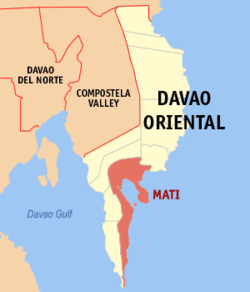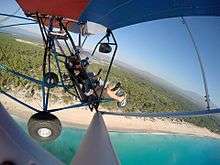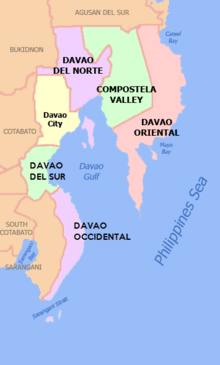Mati, Davao Oriental
| Mati | ||
|---|---|---|
| Component City | ||
| City of Mati | ||
|
Capitol Hill | ||
| ||
|
Nickname(s): "Coconut Capital of the Philippines" | ||
 Map of Davao Oriental with Mati highlighted | ||
.svg.png) Mati Location in the Philippines | ||
| Coordinates: 06°57′N 126°14′E / 6.950°N 126.233°ECoordinates: 06°57′N 126°14′E / 6.950°N 126.233°E | ||
| Country | Philippines | |
| Region | Davao (Region XI) | |
| Province | Davao Oriental | |
| District | 2nd District of Davao Oriental | |
| Founded | 1861 | |
| Incorporated | 1903 | |
| Cityhood | June 16, 2007 | |
| Barangays | 26 | |
| Government[1] | ||
| • Mayor | Carlo Luis P. Rabat (PDP-LABAN) | |
| • Vice Mayor | Glenda Rabat-Gayta (PDP-LABAN) | |
| Area[2] | ||
| • Total | 588.63 km2 (227.27 sq mi) | |
| Population (2015)[3] | ||
| • Total | 141,141 | |
| • Density | 240/km2 (620/sq mi) | |
| Demonym(s) | Matinian | |
| Time zone | PHT (UTC+8) | |
| ZIP code | 8200 | |
| Dialing code | 87 | |
| Income class | 5th class | |
| Website |
mati | |
Mati is the only city in, and the capital of the Province of Davao Oriental, Philippines, located on the south-eastern side of Mindanao. According to the 2015 census, it has a population of 141,141 people.[3] Residents of Mati are called Matinians.
Barangays
Mati is politically subdivided into 26 barangays.[2] In 1957, the barrio then known as Cabuaya was renamed to Dawan.[4]
- Badas
- Bobon
- Buso
- Cabuaya
- Central (City Proper/Poblacion)
- Culian
- Dahican
- Danao
- Dawan
- Don Enrique Lopez
- Don Martin Marundan
- Don Salvador Lopez, Sr.
- Langka
- Lawigan
- Libudon
- Luban
- Macambol
- Mamali
- Matiao
- Mayo
- Sainz
- Sanghay
- Tagabakid
- Tagbinonga
- Taguibo
- Tamisan
History
Mati comes from the Mandayan word Maa-ti which refers to the town's creek that easily dries up even after heavy rain. Pioneer settlers were tribes Kalagan, Mandayan, and Maranao which carried strong Arabic and Indo-Malayan influences.
Captain Prudencio Garcia, the pioneer political-military head in 1861, and his comrade Juan Nazareno founded Mati and two other towns in Davao Oriental. By 1903, Mati was declared a municipality by virtue of Act No. 21. By 1907, Act No. 189 further reaffirmed the establishment of its local government. Francisco Rojas was the first appointed mayor while the first elected mayor was Patricio Cunanan in 1923. Mati became the capital of Davao Oriental since 1967.
The Japanese Imperial forces landed in town and occupied most of eastern Davao region in 1942. Mati was liberated in 1945 by the Allied Philippine Commonwealth troops of the 6th, 10th, 101st, 102nd, 103rd, 104th, 106th, 107th and 110th Infantry Division of the Philippine Commonwealth Army, 10th Infantry Regiment of the Philippine Constabulary and the Davaoeño guerrilla units. Mati celebrated its grand centennial in 2003.
Cityhood issues
-
During the 11th Congress (1998–2001), Congress enacted into law 33 bills converting 33 municipalities into cities. However, Congress did not act on a further 24 bills converting 24 other municipalities into cities.
During the 12th Congress (2001–2004), Congress enacted into law Republic Act No. 9009 (RA 9009), which took effect on 30 June 2001. RA 9009 amended Section 450 of the Local Government Code by increasing the annual income requirement for conversion of a municipality into a city from ₱20 million to ₱100 million. The rationale for the amendment was to restrain, in the words of Senator Aquilino Pimentel, "the mad rush" of municipalities to convert into cities solely to secure a larger share in the Internal Revenue Allotment despite the fact that they are incapable of fiscal independence.
After RA 9009 went into effect, the House of Representatives of the 12th Congress adopted Joint Resolution No. 29, which sought to exempt from the ₱100 million income requirement in RA 9009 the 24 municipalities whose cityhood bills were not approved in the 11th Congress. However, the 12th Congress ended without the Senate having approved Joint Resolution No. 29.
During the 13th Congress (2004–2007), the House of Representatives re-adopted former Joint Resolution No. 29 as Joint Resolution No. 1 and forwarded it to the Senate for approval. However, the Senate again failed to approve the Joint Resolution. Following the suggestion of Senator Aquilino Pimentel (Senate President), 16 municipalities filed, through their respective sponsors, individual cityhood bills. The 16 cityhood bills each contained a common provision exempting it from the ₱100 million income requirement of RA 9009 –
"Exemption from Republic Act No. 9009. — The City of x x x shall be exempted from the income requirement prescribed under Republic Act No. 9009."
On 22 December 2006, the House of Representatives approved the cityhood bills. The Senate also approved the cityhood bills in February 2007, except that of Naga, Cebu which was passed on 7 June 2007. These cityhood bills lapsed into law on various dates from March to July 2007 after President Gloria Macapagal-Arroyo failed to sign them.
On June 20, 2007, the Commission on Elections officially proclaimed the ratification of Republic Act 9408 converting the Municipality of Mati into a component city.
There were 18,267 actual voters out of the 51,287 registered voters in 26 villages and 266 polling precincts during the June 18 plebiscite. Final tabulation showed Yes – 18,267 votes (35.6%); No – 846 (1.6%).[5]
The point of law at issue in 2007 was whether there had been a breach of Section 10, Article X of the 1987 Constitution, which provides –
No province, city, municipality, or barangay shall be created, divided, merged, abolished or its boundary substantially altered, except in accordance with the criteria established in the local government code and subject to approval by a majority of the votes cast in a plebiscite in the political units directly affected.
– and in each case the established criteria were far from met.
In November 2008, Mati and 15 other cities lost their cityhood after the Supreme Court of the Philippines granted a petition filed by the League of Cities of the Philippines, and declared unconstitutional the cityhood law (RA 9408) which had allowed the town to acquire its city status.[6] The Supreme Court ruled that they did not pass the requirements for cityhood.[7][8]
On 10 December 2008, the 16 cities affected acting together filed a motion for reconsideration with the Supreme Court. More than a year later, on 22 December 2009, acting on said appeal, the Court reversed its earlier ruling as it ruled that "at the end of the day, the passage of the amendatory law" (regarding the criteria for cityhood as set by Congress) "is no different from the enactment of a law, i.e., the cityhood laws specifically exempting a particular political subdivision from the criteria earlier mentioned. Congress, in enacting the exempting law/s, effectively decreased the already codified indicators."[9] Accordingly cityhood status was restored.
But on 27 August 2010, the 16 cities lost their city status again, after the Supreme Court voted 7-6, with two justices not taking part, to reinstate the 2008 decision declaring as "unconstitutional" the Republic Acts that converted the 16 municipalities into cities. A previous law required towns aspiring to become cities to earn at least ₱100 million annually, which none of the 16 did.[10]
On 15 February 2011, the Supreme Court made another volte-face and upheld for the third time the cityhood of 16 towns in the Philippines.[11]
Finally, on 12 April 2011, the Supreme Court, in an en banc ruling delivered in Baguio City, affirmed the finality of the constitutionality of the 16 cityhood laws by resolving that:
We should not ever lose sight of the fact that the 16 cities covered by the Cityhood Laws not only had conversion bills pending during the 11th Congress, but have also complied with the requirements of the LGC prescribed prior to its amendment by R.A. No. 9009.[10] Congress undeniably gave these cities all the considerations that justice and fair play demanded. Hence, this Court should do no less by stamping its imprimatur to the clear and unmistakable legislative intent and by duly recognizing the certain collective wisdom of Congress. WHEREFORE, the Ad Cautelam Motion for Reconsideration (of the Decision dated 15 February 2011) is denied with finality.[11]
On 28 June 2011 the Supreme Court directed the Clerk of Court to issue the entry of judgment on the cityhood case of 16 municipalities.[12] This entry of judgment ended the cityhood battle of the 16 cities.
Developments for 2012
After it reclaimed its cityhood status, the local government of the City of Mati focused on infra and eco-tourism projects in 2012 to give the local economy a boost. The local government also improved its education program with the construction of additional school buildings, allotted a bigger budget for health services, and started a housing project worth P13.5 million in Guang-guang. ii
Demographics
| Population census of Mati City | ||
|---|---|---|
| Year | Pop. | ±% p.a. |
| 1990 | 93,023 | — |
| 1995 | 93,801 | +0.16% |
| 2000 | 105,908 | +2.64% |
| 2007 | 122,046 | +1.98% |
| 2010 | 126,143 | +1.21% |
| 2015 | 141,141 | +2.16% |
| Source: National Statistics Office[3][13] | ||
Ethnicity and Languages
Cebuano is the widely spoken language and the corresponding ethnicity accounts for 68.5% of the total household population according to a 2000 census. Mandaya ranks second with 12.74% followed by Kalagan and Boholano with 6.87% and 3.05% respectively. Residents of Mati are migrants from Visayas who came for employment opportunities in logging, mining, farming, fishing, trading and teaching.[14]
Religion
Roman Catholicism is the major religious group, comprising the 80% of the total population. Islam comes in second with 8 percent, Iglesia Ni Cristo comes in third comprising with 6 percent and a small number of believers of other Christian groups like the United Church of Christ and Seventh Day Adventist are in the city as well.[14]
The Cathedral of San Nicolas de Tolentino is the center of Diocese of Mati under the jurisdiction of Roman Catholic Archdiocese of Davao or DADITAMA.
Economy
This region is linked to the markets of Mindanao, Malaysia and Indonesia. Most of the local people rely on agriculture and agro-industries for a living. Exports include bananas, pineapples, coconuts and fish. Because of its tropical nature and beaches, tourism is a rapidly growing business. Mining is also a contributor to the city's economy, due to the large deposits of copper in the city outskirts.[15]
Tourism
Mati offers beautiful landscapes and a number of beautiful resorts. The Provincial Capitol building and park rises atop the hill commanding a fantastic view of the Pujada Bay. Other locations that offer a bird's-eye view of the city are the Mati Tourism Complex and Badas Viewdeck.
Dahican Beach
Mati has always been known as a beach destination, with foreigners flocking to the city to enjoy what its beaches have to offer. Dahican is one of the most popular destinations in Mati with its 17-kilometer pure, fine white sand shore. It has recently become a prime destination for surfers and skimboarders. Pujada Bay boasts 15,700 species of sea life and has been considered as among the richest bays in Southeast Asia. As such, locals take measures to preserve the diversity of marine life, protecting animals like lobsters, sea cows (locally known as Dugong), bottlenose dolphins, hammerhead sharks, manta rays and different kinds of turtles.
Recently, skimboarding, surfing, and frisbee sports have established a wide fandom among young locals with Dahican being the favorite hub for tournaments in the region.
Mati is home to three protected areas, the Mount Hamiguitan Range Wildlife Sanctuary, Mati Protected Landscape, and Pujada Bay Protected Landscape and Seascape.
Mindanao SAGA Flying Club

The Mindanao SAGA Flying Club (MSFC), located at the Mati National Airport in Barangay Dahican, is an Ultralight aircraft flying facility that offers trial flights and flying lessons. Fast becoming the major attraction in Mati, MSFC has introduced a safe, affordable, and an exciting way to see the majestic scenery of the city like no one has seen before. The Quicksilver Sport 2S ultralight is the favorite of visitors owing to its open cockpit that gives the passenger an unrestricted view of the landscape and the feeling of ultimate freedom in the air.
Culture and festivals
Mati celebrates two annual grand festivals: the Pujada Bay Festival every June, and the Sambuokan Festival every October. Compared to the Kadayawan of Davao and other festivals, both of Mati's are relatively new. The Pujada Bay Festival started in 2004 to promote and protect the Pujada Bay, while the Sambuokan Festival started in 2001 to unite Matinians during the commemoration of the municipality's founding anniversary every October 29. In years, both festivals have become alternative tourist destinations as competitors from various regions in the country start pouring in for competitions like streetdancing, boat racing, skimboarding, and frisbee.
Transportation
The pedicab or tricycle is the major means of transportation around the city. In recent years, underbone motorcycles have earned quite a popularity among professionals and students, thus easily becoming a public transport alternative to commuters who prefer more speed. Jeepneys are available for travels from Mati to its neighboring towns while vans and buses are still the only means of transportation from Mati to other cities.
Mati Airport is to commence scheduled operations between late 2012 and early 2013.[15]
Sister cities
 Tagum, Davao del Norte
Tagum, Davao del Norte
References
- ↑ "Official City/Municipal 2013 Election Results". Intramuros, Manila, Philippines: Commission on Elections (COMELEC). 11 September 2013. Retrieved 16 April 2014.
- 1 2 "Province: DAVAO ORIENTAL". PSGC Interactive. Makati City, Philippines: National Statistical Coordination Board. Retrieved 16 April 2014.
- 1 2 3 "Total Population by Province, City, Municipality and Barangay: as of May 1, 2010" (PDF). 2010 Census of Population and Housing. National Statistics Office. Retrieved 16 April 2014.
- ↑ "An Act Changing the Name of the Barrio of Cabuaya, Municipality of Mati, Province of Davao, to Barrio Dawan". LawPH.com. Retrieved 2011-04-12.
- ↑ Sun.Star Davao - Mati now a city
- ↑ Republic Act No. 9408 of 24 March 2007 Charter of the City of Mati
- ↑ G.R. No. 176951 et al. (First appeal) of 18 November 2008 Consolidated petitions for prohibition assailing the constitutionality of the subject Cityhood Laws and enjoining the Commission on Elections (COMELEC) and respondent municipalities from conducting plebiscites pursuant to the Cityhood Laws.
- ↑ Napallacan, Jhunex (2008-11-21). "Cities' demotion worries DepEd execs". Cebu Daily News. Inquirer.net. Retrieved 15 February 2015.
- ↑ G.R. No. 176951 et al. (First reversal) of 21 December 2009
- 1 2 Republic Act No. 9009 of 24 February 2001 An Act amending section 450 of Republic Act no. 7160, otherwise known as the Local Government Code of 1991, by increasing the average annual income requirement for a municipality or cluster of barangays to be converted into a component city.
- 1 2 G.R. No. 176951 et al. (Second appeal) of 15 February 2011 League of Cities of the Philippines v. COMELEC
- ↑ G.R. No. 176951 et al. (Final Resolution) of 28 June 2011 Supreme Court has directed the Clerk of Court to forthwith issue the Entry of Judgment
- ↑ "Province of Davao Oriental". Municipality Population Data. LWUA Research Division. Retrieved 16 April 2014.
- 1 2 "About". Official Website of the City of Mati. Retrieved 21 April 2014.
- 1 2 "Mati Travel Guide, Philippines | Travelgrove.com". travelgrove.com. Retrieved March 30, 2011.
External links
| Wikimedia Commons has media related to Mati City. |
| Wikivoyage has a travel guide for Mati. |
- City of Mati Official Website
- Pujada Island - Resort Development Opportunity
- Philippine Standard Geographic Code
- Philippine Census Information
- Local Governance Performance Management System
- Mindanao SAGA Flying Club
 |
Lupon | Tarragona |  | |
| San Isidro | |
Philippine Sea | ||
| ||||
| | ||||
| Gov. Generoso | Philippine Sea |

